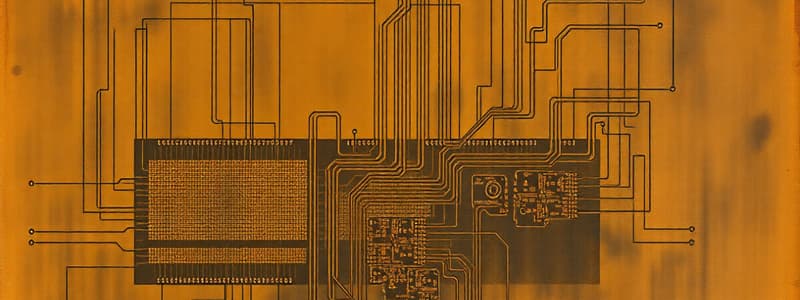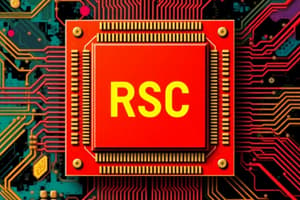Podcast
Questions and Answers
What does it indicate when the Zero signal from the ALU is asserted?
What does it indicate when the Zero signal from the ALU is asserted?
It indicates that the register values are equal.
How is the branch instruction offset modified for execution?
How is the branch instruction offset modified for execution?
The branch instruction offset is modified by adding the PC to the instruction's 12 bits shifted left by 1 bit.
What is a significant challenge when creating a single datapath for instruction execution?
What is a significant challenge when creating a single datapath for instruction execution?
A significant challenge is that no datapath resource can be used more than once per instruction.
Why is separate memory needed for instructions and data in a single datapath implementation?
Why is separate memory needed for instructions and data in a single datapath implementation?
What is the role of control signals in the datapath for executing multiple instruction classes?
What is the role of control signals in the datapath for executing multiple instruction classes?
What is the purpose of the program counter (PC) in the RISC-V datapath?
What is the purpose of the program counter (PC) in the RISC-V datapath?
Why is it necessary to have an adder within the RISC-V datapath?
Why is it necessary to have an adder within the RISC-V datapath?
Describe the role of control signals in the datapath components.
Describe the role of control signals in the datapath components.
What distinguishes a control signal from a data signal in the context of a datapath?
What distinguishes a control signal from a data signal in the context of a datapath?
What is the significance of the register file being read and written in the same clock cycle?
What is the significance of the register file being read and written in the same clock cycle?
What is the role of the program counter (PC) in the instruction fetching process?
What is the role of the program counter (PC) in the instruction fetching process?
Describe the function of R-format instructions within the context of the processor's datapath.
Describe the function of R-format instructions within the context of the processor's datapath.
Explain why instruction memory is treated as combinational logic in the datapath.
Explain why instruction memory is treated as combinational logic in the datapath.
How does the adder function in relation to the program counter and instruction fetching?
How does the adder function in relation to the program counter and instruction fetching?
What characteristics of the program counter enable it to function effectively at the end of each clock cycle?
What characteristics of the program counter enable it to function effectively at the end of each clock cycle?
Flashcards
Program Counter (PC)
Program Counter (PC)
A register that holds the memory address of the next instruction to be fetched.
Instruction Memory
Instruction Memory
A component that stores instructions in a program.
R-format Instructions
R-format Instructions
Instructions that read two registers, perform an ALU operation, and write the result to a register.
ALU Operation
ALU Operation
Signup and view all the flashcards
Instruction Fetch
Instruction Fetch
Signup and view all the flashcards
Incrementing the PC
Incrementing the PC
Signup and view all the flashcards
RISC-V Datapath
RISC-V Datapath
Signup and view all the flashcards
Register File
Register File
Signup and view all the flashcards
Instruction Memory
Instruction Memory
Signup and view all the flashcards
Program Counter (PC)
Program Counter (PC)
Signup and view all the flashcards
Adder (datapath element)
Adder (datapath element)
Signup and view all the flashcards
ALU
ALU
Signup and view all the flashcards
Datapath elements
Datapath elements
Signup and view all the flashcards
64-bit RISC-V architecture
64-bit RISC-V architecture
Signup and view all the flashcards
ALU Zero Signal
ALU Zero Signal
Signup and view all the flashcards
Branch Instruction
Branch Instruction
Signup and view all the flashcards
Branch Offset
Branch Offset
Signup and view all the flashcards
Single Datapath
Single Datapath
Signup and view all the flashcards
Instruction Memory (separate from Data Memory)
Instruction Memory (separate from Data Memory)
Signup and view all the flashcards
Duplicated Functional Units
Duplicated Functional Units
Signup and view all the flashcards
One-Clock Cycle Execution
One-Clock Cycle Execution
Signup and view all the flashcards
Study Notes
Building a Datapath
- A reasonable datapath design starts by examining major components needed to execute RISC-V instructions.
- The design progresses from the top down, observing which datapath elements each instruction needs.
- Abstraction is used in the explanation, starting with the bottom-up approach. Control signals are shown alongside datapath elements.
Instruction Memory and Program Counter
- Figure 4.5a shows a memory unit storing program instructions accessible by address.
- Figure 4.5b shows the Program Counter (PC) as a register holding the current instruction's address.
- An adder is needed to increment the PC to the next instruction address. This adder can be built from an Arithmetic Logic Unit (ALU) configured for addition operation.
Datapath for Instruction Fetching
- Figure 4.6 illustrates combining elements (memory, PC, adder) to fetch instructions and increment the PC.
R-Format Instructions
- R-format Instructions (Figure 2.19, page 127):
- Read two registers.
- Perform an ALU operation on register contents.
- Write the result to a register.
Register File
- The processor's 32 general-purpose registers are stored in a register file.
- Any register can be read or written by specifying its number within the file.
- The register file holds the register state of the computer.
- The register file needs two read ports and one write port.
Arithmetic Logic Unit (ALU)
- An ALU is needed to operate on register values.
- The ALU takes two 32-bit inputs and produces a 32-bit result.
- A 4-bit control signal dictates the ALU operation.
Data Memory
- Needed to fetch and write data; has read and write control signals, address input and input for data to be written.
- Figure 4.8 illustrates the data memory unit and its input/outputs.
Immediate Generation Unit (ImmGen)
- Converts 12-bit instruction offset into 32-bit signed value for load, store.
- ImmGen uses instruction opcode to select the appropriate 12-bit field (for load, store, and conditional branch)
- Figure 4.8 illustrates the Immediate Generation Unit.
Branch Instructions (e.g., beq)
- Branch instructions (e.g., beq x1, x2, offset) compute the branch target address by adding the sign-extended offset field and the PC.
- They calculate whether the target address becomes the new PC or if the program proceeds sequentially (branch not taken).
- Figure 4.9 illustrates the datapath structure for branch instructions; it involves immediate generation and comparison using the ALU.
Datapath for memory instructions and R-type Instructions
- Figure 4.10 diagrams a single datapath for both memory and R-type instructions, showing the need for multiplexors (for ALU and Register file data inputs).
- The figure emphasizes how a single datapath can be implemented using multiplexors to select appropriate inputs based on the instruction type.
Combined Datapath (Figure 4.11)
- The final combined datapath integrates components for instruction fetch, R-type/memory instructions and branches on a single design.
- Multiplexors are used for different data and control inputs.
Studying That Suits You
Use AI to generate personalized quizzes and flashcards to suit your learning preferences.




